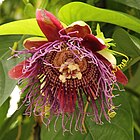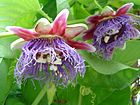Note: This is a project under development. The articles on this wiki are just being initiated and broadly incomplete. You can Help creating new pages.
Passiflora quadrangularis
Passiflora quadrangularis, the giant granadilla, barbadine (Trinidad), grenadine (Haiti), giant tumbo or badea (Spanish pronunciation: [baˈðe.a]), is a species of plant in the family Passifloraceae. It produces the largest fruit of any species within the genus Passiflora. It is a perennial climber native to the Neotropics.
Contents
- 1 Uses
- 2 Parts Used
- 3 Chemical Composition
- 4 Common names
- 5 Properties
- 6 Habit
- 7 Identification
- 8 List of Ayurvedic medicine in which the herb is used
- 9 Where to get the saplings
- 10 Mode of Propagation
- 11 How to plant/cultivate
- 12 Commonly seen growing in areas
- 13 Photo Gallery
- 14 References
- 15 External Links
Uses
treatment of liver problems, treatment of headaches, asthma , diarrhea, dysentery , neurasthenia, insomnia.
Parts Used
Chemical Composition
Quadrangularis were found flavones C,O-diglycosides, saponins (cyclopassifloside derivatives) and cyanogenic glycosides. Two of the flavones C,O-diglycosides found in this hydroethanolic extract, compounds 6 and 7, were also found in P. [1]
Common names
| Language | Common name |
|---|---|
| Kannada | |
| Hindi | |
| Malayalam | |
| Tamil | |
| Telugu | |
| Marathi | NA |
| Gujarathi | NA |
| Punjabi | NA |
| Kashmiri | NA |
| Sanskrit | |
| English | giant granadilla, barbadine (Trinidad), grenadine (Haiti) |
Properties
Reference: Dravya - Substance, Rasa - Taste, Guna - Qualities, Veerya - Potency, Vipaka - Post-digesion effect, Karma - Pharmacological activity, Prabhava - Therepeutics.
Dravya
Rasa
Guna
Veerya
Vipaka
Karma
Prabhava
Habit
Identification
Leaf
| Kind | Shape | Feature |
|---|---|---|
| Simple | round in outline | Alternate; thin, with conspicuous veins sunken on the upper surface, prominent beneath |
Flower
| Type | Size | Color and composition | Stamen | More information |
|---|---|---|---|---|
| Bisexual | bell-shaped calyx | whiteish blue | up to 4-4.8 in. (10-12 cm) wide, Pendulous; showy; solitary; fragrant flowers |
Fruit
| Type | Size | Mass | Appearance | Seeds | More information |
|---|---|---|---|---|---|
| Simple Fruit | ovoid | Berry; aromatic; melon-like; delicate skin | greenish-white/pale- or-deep-yellow | {{{6}}} |
Other features
List of Ayurvedic medicine in which the herb is used
Where to get the saplings
Mode of Propagation
How to plant/cultivate
In commercial plantings in Indonesia, the vines are set 6.5 to 10 ft (2-3 m) apart each way. Harm 30 °F (-1.1; kill 28 °F (-2.2 °C). [3]
Commonly seen growing in areas
Photo Gallery
References
External Links
- [https://www.growables.org/information/TropicalFruit/Granadilla.htm Passiflora quadrangularis
]
- Ayurvedic Herbs known to be helpful to treat treatment of liver problems
- Ayurvedic Herbs known to be helpful to treat treatment of headaches
- Ayurvedic Herbs known to be helpful to treat asthma
- Ayurvedic Herbs known to be helpful to treat diarrhea
- Ayurvedic Herbs known to be helpful to treat dysentery
- Ayurvedic Herbs known to be helpful to treat neurasthenia
- Ayurvedic Herbs known to be helpful to treat insomnia
- Herbs with Fruits used in medicine
- Herbs with Leaves used in medicine
- Herbs with common name in English
- Habit - Herbs
- Index of Plants which can be propagated by Seeds
- Herbs that are commonly seen in the region of Lowland forest
- Herbs
- Passifloraceae



